The right B2B SEO strategy is vital to a company’s success. B2B marketers have relied on traditional marketing methods for years with much success. However, the digital age has changed b2B marketing tactics, and SEO is front and center.
Search Engine Optimization (SEO), in the simplest of terms, is the process of improving website visibility in search engines (Google, Bing, etc.). Theoretically, the more visible a website (organic rankings), the more visitors become clients.
Driving traffic from SEO efforts has many facets, including technical and creative. And B2B SEO is a fine art that, when done right, will produce a strong sales funnel and, ultimately, a high conversion rate.
Opportunities for B2B SEO Strategies
While B2B marketers embrace SEO strategies, they are often poorly executed, do not produce immediate results, or the labor costs and investments are too high.
B2B SEO Execution
SEO for B2B is often misunderstood. Establishing a strong SEO strategy involves a holistic view of all marketing initiatives and a deep understanding of how each aspect of marketing interacts with and impacts the other. B2B marketers are uniquely positioned to fully understand the holistic view based on their experience with traditional and digital marketing tactics.
However, B2B marketers often face obstacles such as budget constraints, labor resources, and executive support.
The result is an SEO strategy that is fragmented – maybe metadata is SEO optimized, but website content is not. The result is an inconsistent SEO strategy that will undermine the efforts implemented.
What is the best SEO strategy for B2B?
The B2B sales funnel is complex, lengthy, and involves numerous stakeholders. The B2B sales funnel often takes two or more months, while B2C companies can have a sales cycle of five minutes.
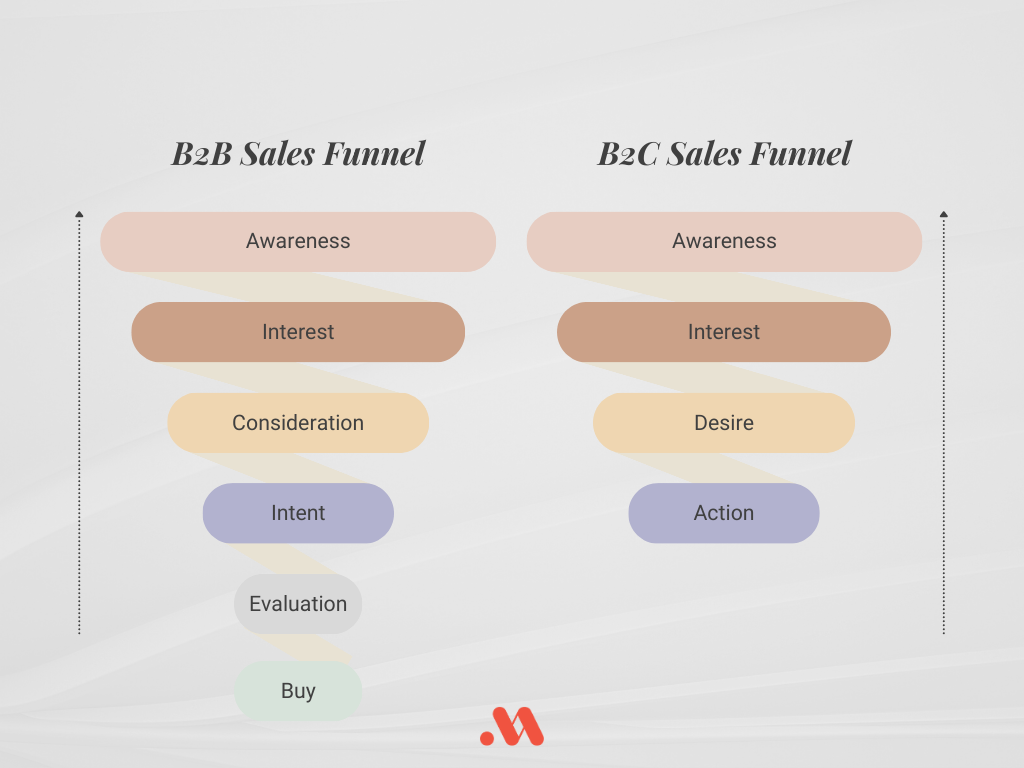
This means that B2B marketing and lead generation strategies must be tailored to all sales funnel stages.
By implementing sound SEO strategies, B2B companies can rank for the keywords at each stage so they are always visible to leads and prospects. This can be accomplished with creative content relevant to several layers of the lead’s organization.
The best B2B SEO strategy begins with knowing your ideal client profile (ICP) and sales funnel, current SEO rankings, and the state of your website. Spending time researching and documenting the current state, and collaborating with the IT, web development, and sales teams, will ultimately provide you with an excellent foundation and SEO strategy.
A Strong Foundation for B2B SEO Strategy
Creating a strong B2B SEO strategy begins with research. This is tedious and lengthy but the most crucial step.
Understanding the B2B client
ICP & Buyer Personas
Creating an Ideal Client Profile (ICP) is the basis of a strong SEO strategy. The ICP is created from various sources, including internal research, market research, existing clients, and quantitative data, such as website visitors.
In addition to the ICP, Buyer Personas are just as important. While the ICP defines the ideal client, the buyer persona identifies the individual you are selling to. This is extremely important since the buyer will be doing the initial research and reading your content.
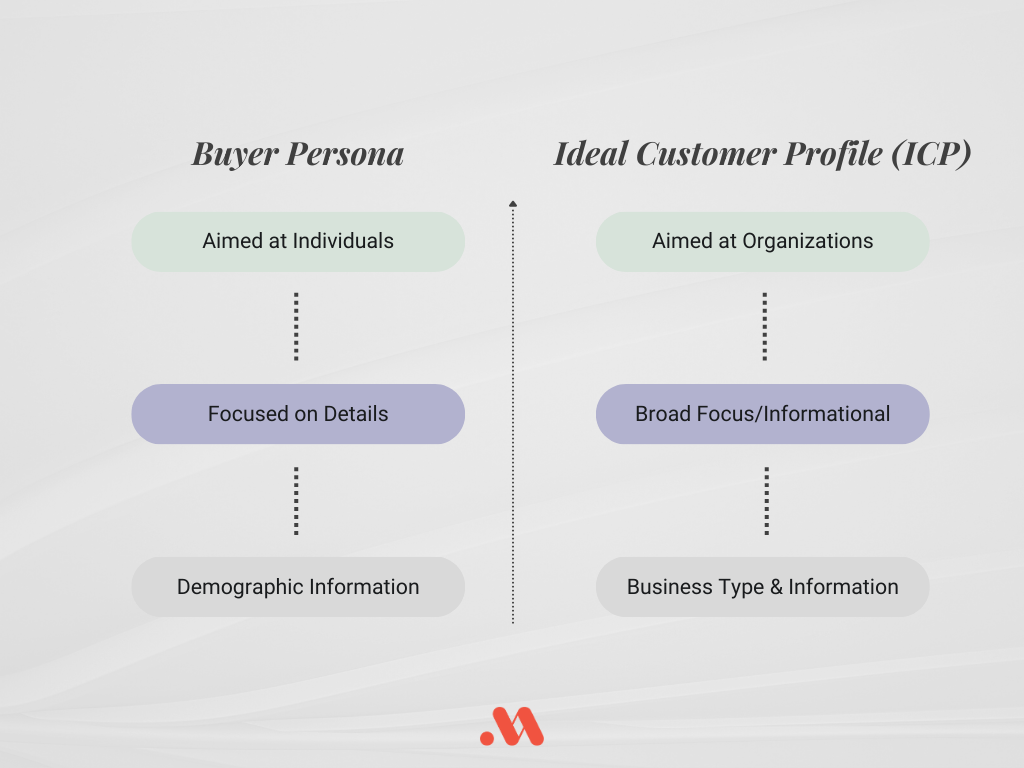
The Sales Funnel
Understanding your sales funnel is another vital component of a comprehensive B2B SEO strategy. Work with your sales team to understand the funnel and what currently is working and what is not working. Are the generated leads viable?
The length of the sales cycle is one metric that will impact the SEO strategy. Other data to consider are retention rate and why clients leave. One metric not always reported on but vitally important is CLTV (customer lifetime value). This metric is important because it takes into consideration the amount of marketing dollars spent and, along with retention rates, the value of the customer.
Why calculate CLTV for an SEO strategy? Knowing where your customers come from, how much ad spend was needed to acquire them, and how much revenue they generate(d) for the company can help identify ideal clients and what content they need to make their decision.
SEO Research and Analysis
Now that there is a clear ICP, buyer persona, and sales funnel understanding, it’s time to research current SEO rankings. Using the right tools will make research easier, and with the plethora of tools, it’s critical to use high-quality research options. There are hundreds of SEO research tools available, and as with an SEO strategy, quality matters.
Utilizing multiple tools is the right way to approach SEO research. Many tools are vital in some research and not others. The right SEO research tools will vary depending on your analysis.
Top SEO Research Tools
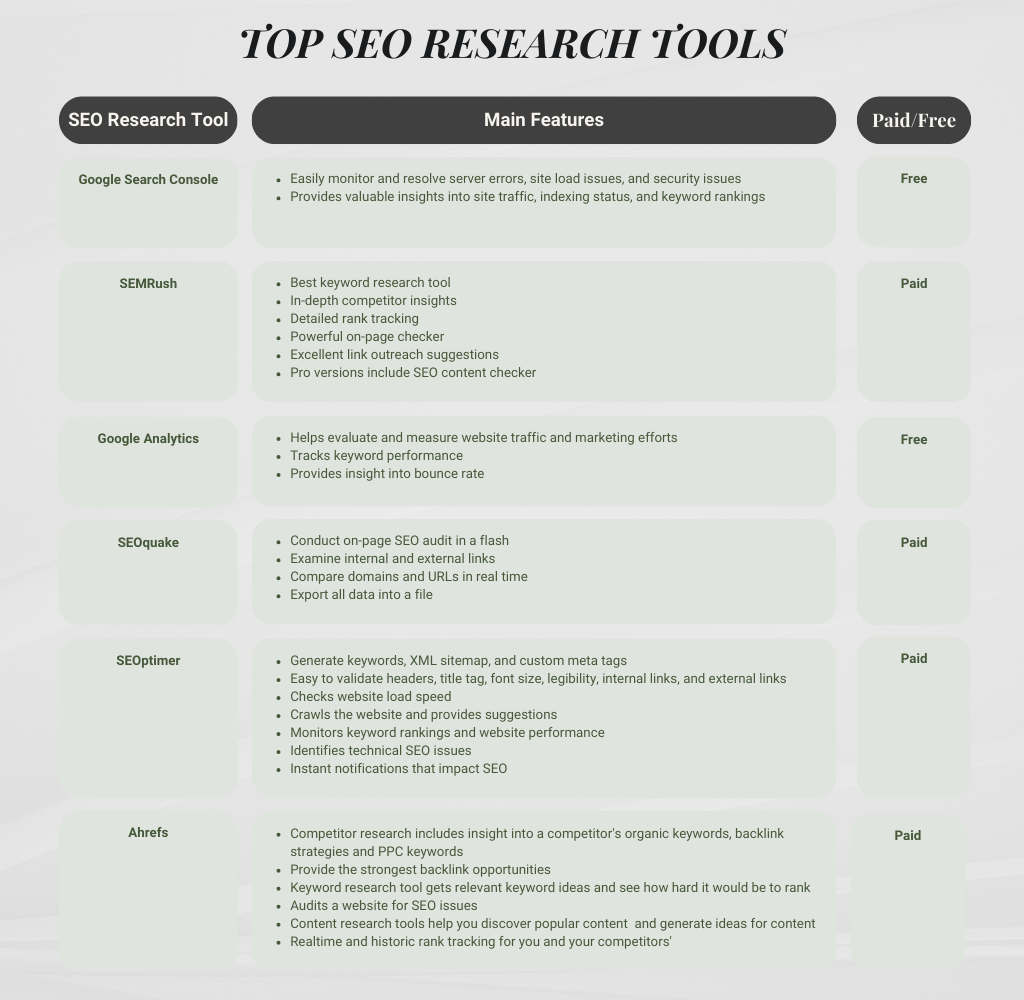
For the research and analysis stage, remember that you won’t just analyze your SEO efforts; you will also analyze your competitors.
In the words of Maya Angelou, “You can’t really know where you are going until you know where you have been.” This will be the mantra for this stage of creating the SEO strategy!
SEO Analysis – Looking Inward
When analyzing your website, the metrics are extensive, and if you are not an SEO guru, many can become detractors in your analysis. The main goal of analyzing your website is to identify the “four pillars of SEO” and optimize the website.
Four Pillars of SEO
- Technical SEO optimization results in search engines able to discover, crawl, and index your web pages. The main elements include crawlability, indexability, mobile-friendliness, speed, and website structure.
Technical SEO Audit Checklist:
- Submit your sitemap to Google
- Use HTTPS
- Create an SEO-friendly site structure
- Improve your website’s speed
- Make your website mobile-friendly
- Find and fix duplicate content issues
- Find and fix broken pages (404 errors)
- On-page SEO optimizes a web page to improve organic rankings and earn organic traffic.
On-page SEO Audit Checklist:
- Make sure every page has meta titles and meta descriptions
- Make sure all images have Alt tags and are compressed
- Internal linking
- External linking to reputable sites
- Use heading and subheading page structure
- Optimized URLs
- Content is the key to a B2B SEO strategy! Content SEO refers to content that is unique, relevant, and structured for search engines to discover and crawl. High-quality content is worth the investment, and using an experienced agency or SEO content writer will significantly impact your organic rankings.
Content SEO Audit Checklist:
- Audit website content for uniqueness
- Unique target keyword per page
- Good site structure (pyramid structure)
- Off-page SEO refers to the practices that are applied outside of your website. These include backlinks and mentions on other websites. Ideally, these other sites should link to your site.
Off-page SEO Audit Checklist:
- Link building (backlinks)
- Content marketing
- Podcasts
- Review sites
- Events (trade shows)
Since a strong B2B SEO strategy is based on an SEO-optimized website according to the four pillars, the next step in your analysis will be one of the most fun (and often discouraging) – competitor analysis.
Competitor SEO Audit
After you complete your internal SEO audit, it’s time to see where your website ranks in relation to your competitors. Tools like Semrush allow you to conduct competitor website audits and identify where you are excelling and where you have gaps uncovering the SEO optimizations you need to plan for.
Running an SEO audit on your competitors will provide you with all the details from your audit, allowing you to make a quick comparison. In addition to the website audit, two essential gap analyses need to be done: Keyword Gap and Backlink Audit.
Keyword Gap Analysis
The unsung hero of competitor analysis – the keyword gap analysis – is often not done. Keyword gap analysis uncovers intelligence on your competitors, allowing you to compare your keyword ranking to a competitor’s SEO ranking. By identifying keyword opportunities, you can structure your B2B SEO strategy to include content targeting the missing keywords.
Backlink Gap Analysis
The backlink gap analysis is very similar to the keyword gap analysis described above. By auditing your competitors’ backlinks, you may identify new websites you can solicit for backlinks or share your content, thereby earning a backlink. Something to keep in mind when identifying potential backlinking sites is their domain authority or reputation.
Quality matters with backlinking. A website can have over 20,000 backlinks, but if those backlinks are not from reputable sites, they are not worth much and can actually damage your SEO rankings. It is essential to target high-quality websites for backlinking.
Creating a Strong B2B SEO Marketing Strategy
With the foundational work completed, the actual SEO strategy can be created!
Using B2B SEO Strategy templates and checklists will go a long way in keeping the SEO strategy organized, executable, and (most importantly) measurable. Without goals and metrics, you can’t measure your success.
Depending on the audit results, knowing where to start can be a bit daunting. Jumping into technical errors, such as missing meta titles and descriptions, may seem like a good place to start, but it is not.
Website Structure / Architecture
Your website structure allows search engines to understand what information is available on your website. Search engine algorithms use website data and content to determine how relevant your site is to a particular search query. If your website has structured data, it makes it easier for search engines to crawl and index your pages.
Once search engines (Google) understand your webpage, the better you’re ranking, and the more users will find your business.
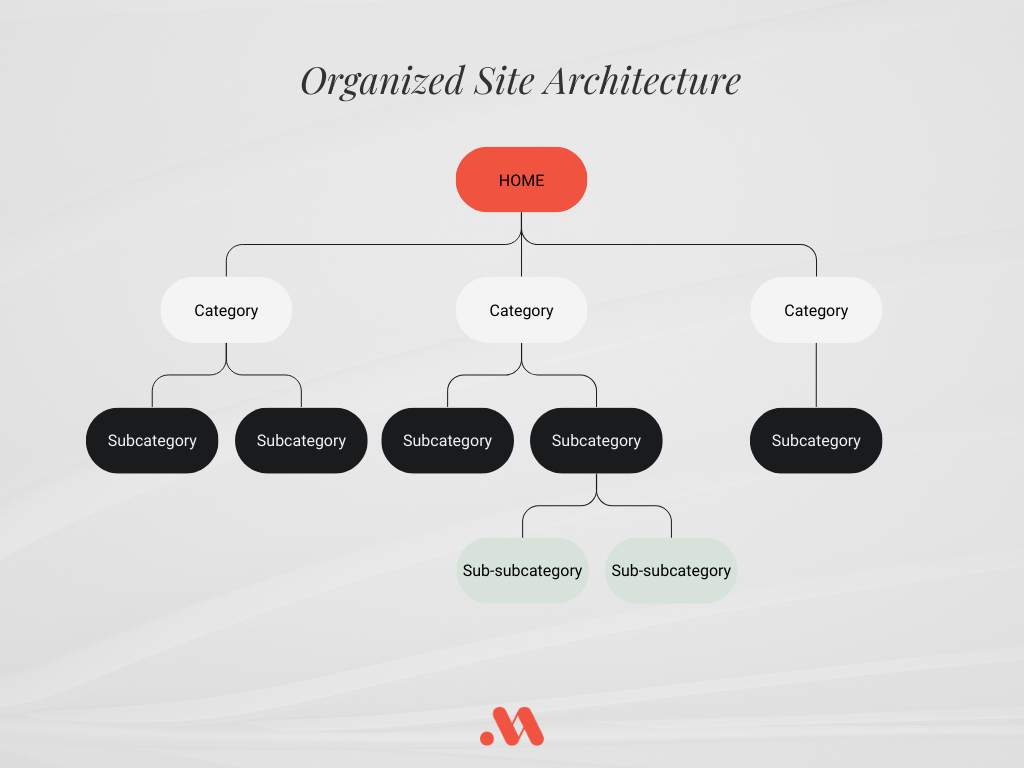
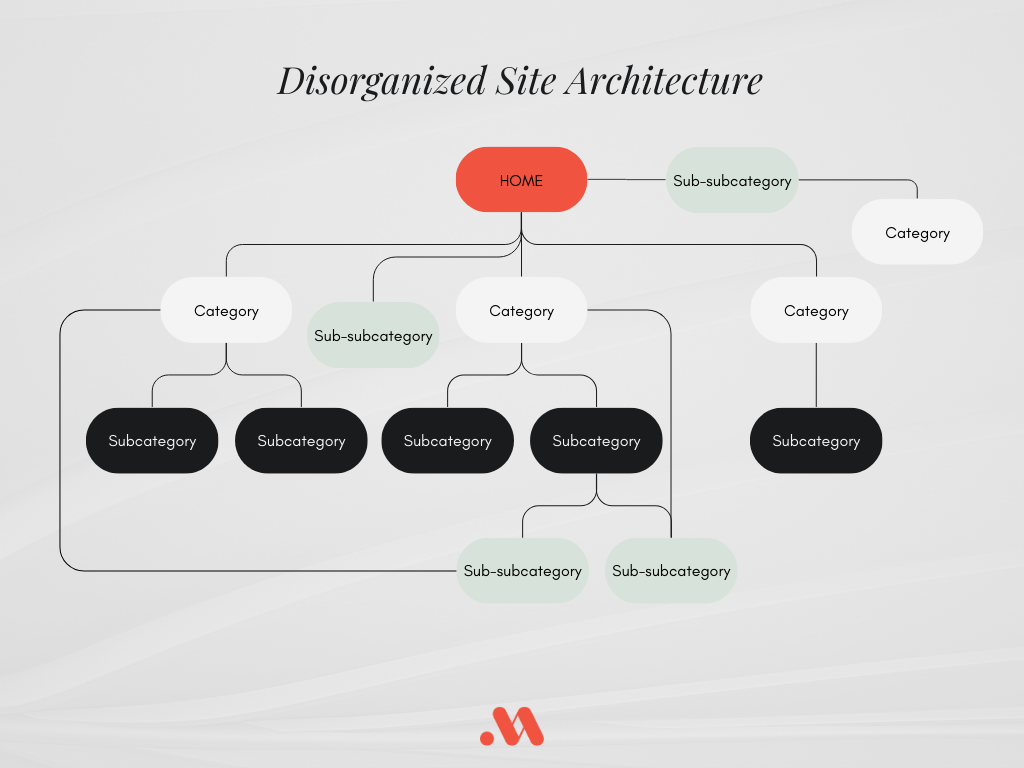
Internal Linking
As you are reviewing your site architecture, it is a good time to review internal linking opportunities. An integral part of your SEO strategy, internal linking serves many purposes. The main goal is to have visitors stay on your site, consuming your content for more extended periods.
Time on site is an important metric in B2B SEO since search engines view this metric as relevant. Since Google can only record the time between a user landing on one webpage and going to another on your site, internal linking may become even more critical.
Blogs are a great source for internal linking. They can link to main pages, category pages, and any subsequent pages.
Strategic SEO Keywords
The next step to successful SEO strategies is keyword definitions. Defining each page’s target or primary keyword provides the information needed to optimize metadata and page content. Without identifying these keywords, the SEO strategy will not be cohesive.
Keywords can be short- or long-tail with high or low difficulty. Going back to the lengthy B2B sales cycle, it is important to have high organic rankings for short-tail keywords (often more generic) and long-tail keywords (more descriptive). This is due in part to how B2B searches are conducted.
Example:
- Initial search: “document management”
- Secondary search: “document management system”
- Tertiary search: “document management software for car dealerships”
As the user refines the search, the keywords get more specific, ensuring that the short-and-long-tail keywords have landing pages and supporting content that will go a long way in organic rankings.
Long-tail keywords often have lower overall search volume. However, since they are highly specific, their conversion rate may be higher. This is your audience. Ranking for high-volume and low-volume keywords is also necessary for another reason.
High organic rankings for long-tail keywords and low-volume keywords positively impact short-tail and high-volume keywords. Once Google identifies your content as valuable and moves it up in the SEO rankings, Google will then begin to “take notice” and may crawl your site more often. Ultimately giving your site higher organic rankings for those coveted broad keywords.
A word of caution, when choosing keywords, make sure they make sense to people. At the end of the day, it’s your buyer persona that is doing the searches. From your ICP and Buyer Persona research, you know your customers. Your B2B SEO strategy efforts should quickly identify the pain points and your resolution – why your business is THE solution.
Going back to the example above, the initial search of “document management” only identifies that a company needs assistance managing its paperwork. By the last search, “document management software for car dealerships”, not only is the pain point identified, but important industry information is also denoted.
Keyword Cannibalization
Keyword cannibalization sounds as bad as it is. Keyword cannibalization is when a webpage has more than one focused keyword, confusing search engines.
Many Marketing 101 classes talk about single-message marketing. Another acronym is KISS. The same theory applies to SEO strategies. Keeping web pages focused on one primary, targeted keyword solidifies the web page’s message. It is clear to users and just as importantly, to Google bots.
To prevent keyword cannibalization, stick to using the unique keyword you have identified for the page.
Metadata
Armed with targeted keywords, the next step is to optimize metadata. Using each webpages unique keyword, review and optimize Meta Titles and Meta Descriptions. Although metadata is not considered an important factor for SEO rankings, they have an impact on how your webpages appear in search results. Having clear, concise – and relevant – meta titles and descriptions can improve the user experience. And the more users click, the more a search engine will view your website as relevant. This can lead to improved SEO organic rankings.
Alt Text
Alt text, short for alternative text, is sometimes not a top SEO strategic goal. Alt text is designed for the visually impaired to understand your website better, specifically to understand images. Alt text was originally introduced in 1993. However, it didn’t become mandatory until 1999.
Alt text is extremely important for images and social media sites, such as Instagram. Each image on your website needs to have alt text. Alt text needs to be concise and relevant descriptions. Google’s Alt text guidelines are a great resource while detailing their importance.
To reduce the chances of duplicate alt tags, use a template to keep track of image titles. This simple document should identify an image, its URL/location, and the Alt text. Not only does this help you keep track of your images and locations, but it can also play a vital role in knowing when to update images.
Content
At the heart of every strong SEO strategy is content. And quality content is more important today than when the phrase “Content is King” was coined back by Bill Gates in 1996. With privacy laws evolving, the cookieless future, and the prevalence of ad blockers, content will be the backbone of all SEO strategies. It can even impact a company’s success or failure.
There are many types of content, and each is integral to SEO strategies.
Landing Pages
Landing pages are important in every B2B marketing strategy – SEO and SEM. In a paid search marketing strategy, you may have seen one of your Google Ads marked as Low quality or Poor relevancy. This means that Google had difficulty finding the landing page relevant to the keyword searched. For example, if a user searches document management for car dealerships and the ad content and landing page have “Document Management for Healthcare”, the ad and landing page is not relevant to what was searched.
The same theory goes for SEO. If your landing page is not optimized for your targeted keyword, you essentially will lose rankings and leads.
Optimized landing pages make or break the number of leads you acquire. Landing pages should be purpose-driven, such as for a new product launch or tradeshow speaking event.
The landing page’s content needs to be well organized, relevant, and with an optimized form capturing a visitors’ contact information. The forms’ CTA needs to be relevant to the landing page. If the landing page is for a tradeshow, it should not be tailored to a new product launch.
H1 Tags
On all web pages – including landing pages – H1 tags play an important role in SEO strategies. H1 is the HTML tag applied to the most important title on each web page. Search engines use the H1 tag as a ranking factor when determining what your content is about.
Just like having one targeted keyword per page, there should only be one H1 per page. H1 tags need to contain the target keywords.
Blogs
Blogging is a major part of content marketing and vital to a business’s SEO strategy.
Blogging serves many purposes, including establishing thought leadership, giving credibility to your website, and creating backlinking opportunities. Your B2B SEO efforts absolutely need to include blogging – high-quality, long-form, frequent blogs are the way to go.
The term “thought leadership” gets used a lot. But what is a thought leader, and how do you establish thought leadership?
Thought leaders, as defined by Business News Daily, are people “who, based on their expertise and industry perspective, offer unique guidance, inspire innovation, and influence others.” Prominent marketing thought leaders include Neil Patel and Seth Godin. While aspiring to their influence may seem untenable, the blogging path will put you on the right path.
Producing high-quality, unique content that provides valuable information goes a long way in establishing thought leadership. Becoming an authority in your industry can take time, but it is well worth the work. Your thought leadership blogs can also be used in PR efforts, industry publications, and on your site. This blog sharing is a great way to garner industry publications’ backlinks.
Another aspect of establishing thought leadership is to contribute to industry websites. Contributing unique content to their site establishes you as a credible source of information.
Producing high-quality content takes time. Most SEO strategies include frequent blogging – often up to twice a week. While this may be the ideal cadence, it is secondary to the quality. Well-thought-out content with authoritative links, often with 4,000 words or more, will produce better SEO results than your 750-word blog that does not provide the valuable information you need. Don’t produce subpar content just to hit a posting deadline; it can have the opposite effect on SEO efforts.
Great blogs are not just text. They contain infographics, images, and statistics. Remember to cite all sources and link to the original content. And, of course, ensure all images and infographics have Alt Tags! Google can immediately identify duplicate content or plagiarism– unique content is mandatory. Tools like Semush have a content checker that will check the originality of your blogs, among other metrics. Utilizing tools such as these is highly encouraged to confirm your content is unique and readable.
Long-Form Content
Long-form content is a powerful aspect of B2B marketing SEO strategies. Long-form content can be in various forms, but it is always over 2,200 words. In addition to blogs, long-form content includes case studies, podcasts (and their transcripts), eBooks, and guides.
Long-form content outperforms short-form content organically every time. This is due to two main reasons – search engines look at time on site as a relevant metric and long-form content usually takes 4-5 minutes to read.
“If Google has the choice to show two articles for the same keyword, which one are they going to choose: The one where readers average 45 seconds on the page or the one where readers average 4.5 minutes on the page?” – Marcus Sheridan, Keynote Speaker, Author, and Partner, IMPACT
Long-form content also can capture your share of voice (SOV), especially in social media, specifically LinkedIn, for B2B content.
Now that you have long-form content, ensuring that the reader easily digests it is crucial. The content layout, clear CTA, images, and infographics are necessary for readers to navigate. Don’t neglect section headings and white space, either. These are important components of readability. Finally, your content needs to be engaging for the reader to stay on your site.
Mobile Optimization
A few years ago, Google rolled out its Mobile-first Index, which ranks search results based on mobile versions of a website – and with good reason. In 2023, mobile searches now make up an astounding 60% of internet searches. Mobile optimizations have a powerful impact on SEO rankings.
Mobile optimizations include:
- Create an “M.” version of your website. This indicates a mobile version.
- Responsive web design. This keeps your content under one URL but adapts to the user’s device.
- Perform a Mobile Usability check in Google Search Console.
- Limit or remove pop-up and interstitial ads.
- Ensure all of your content is available on mobile devices.
Ongoing SEO Efforts
SEO is not a “one-and-done” marketing strategy. It requires constant attention and evaluation. Proactively crawling and fixing website issues goes a long way in preventing lost organic rankings.
It is suggested that reviewing the checklist you used to evaluate your original SEO rankings is revisited every quarter if you do not have a dedicated SEO expert on your marketing team. Establishing weekly reporting can also identify any SEO optimizations that need to be taken.
Reporting and Analytics
After all the time it takes to create a strong B2B SEO strategy, it is important to establish goals and KPIs. SEO efforts take time, and the results are not immediately seen. Sometimes, the needle may not move for six months, so reporting on all SEO gains is essential, and these efforts compound and build on each other.
Conclusion
Need help with SEO questions? Maxamy has dedicated B2B SEO experts who can help. Contact us to see how we can help you strategize for success today and beyond!


